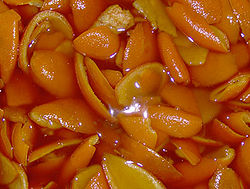Candied fruit
Candied fruit, also known as crystallized fruit or Glace fruit, has been around since the 14th century. Whole fruit, smaller pieces of fruit, or pieces of peel, are placed in heated sugar syrup, which absorbs the moisture from within the fruit and eventually preserves it. Depending on size and type of fruit, this process of preservation can take from several days to several months.[1] The continual process of drenching the fruit in syrup causes the fruit to become saturated with sugar, preventing the growth of spoilage microorganisms due to the unfavourable osmotic pressure this creates.[2] Fruits that are commonly candied include dates, cherries, pineapple, and ginger.[3] The principal candied peels are orange and citron; these with candied lemon peel are the usual ingredients of mixed chopped peel (which may also include glace cherries). The marron glace is among the most prized of candied confections. Recipes vary from region to region, but the general principle is to boil the fruit, steep it in increasingly strong sugar solutions for a number of weeks, and then dry off any remaining water.[4] [edit]History Food preservation methods using sugar (palm syrup and honey) were known to the ancient cultures of China and Mesopotamia. However, the precursors of modern candying were the Arabs, who served candied citrus and roses at the important moments of their banquets[citation needed]. With the Arab domination of parts of southern Europe, candied fruit made its way to the West. The first documents that demonstrate the use of candied fruit in Europe date back to the sixteenth century[citation needed]. In Italy, they became a key ingredient of some of the most famous sweets of its culinary tradition: among these, the Milanese Panettone and the Cassata Siciliana. In cooking, a syrup or sirup (from Arabic: ?; sharab, beverage, wine, via Latin: sirupus)[1] is a thick, viscous liquid consisti

g primarily of a solution of sugar in water, containing a large amount of dissolved sugars but showing little tendency to deposit crystals. The viscosity arises from the multiple hydrogen bonds between the dissolved sugar, which has many hydroxyl (OH) groups, and the water. Syrups can be made by dissolving sugar in water or by reducing naturally sweet juices such as cane juice, sorghum juice, or maple sap. Corn syrup is made from corn starch using an enzymatic process that converts it to sugars. Technically and scientifically, the term syrup is also employed to denote viscous, generally residual, liquids, containing substances other than sugars in solution. Preservation usually involves preventing the growth of bacteria, fungi (such as yeasts), and other micro-organisms (although some methods work by introducing benign bacteria, or fungi to the food), as well as retarding the oxidation of fats which cause rancidity. Food preservation can also include processes which inhibit visual deterioration, such as the enzymatic browning reaction in apples after they are cut, which can occur during food preparation. Many processes designed to preserve food will involve a number of food preservation methods. Preserving fruit by turning it into jam, for example, involves boiling (to reduce the fruit’s moisture content and to kill bacteria, yeasts, etc.), sugaring (to prevent their re-growth) and sealing within an airtight jar (to prevent recontamination). There are many traditional methods of preserving food that limit the energy inputs and reduce carbon footprint.[1] Maintaining or creating nutritional value, texture and flavour is an important aspect of food preservation, although, historically, some methods drastically altered the character of the food being preserved. In many cases these changes have now come to be seen as desirable qualities – cheese, yoghurt and pickled onions being common examples.